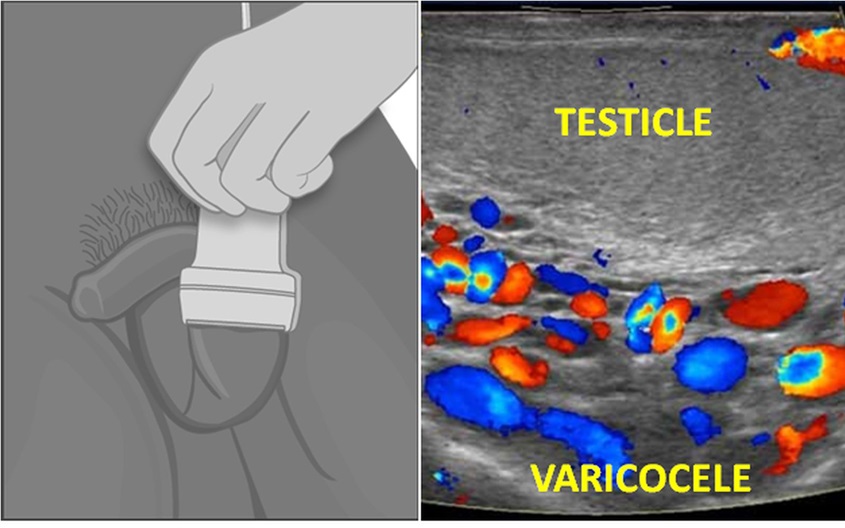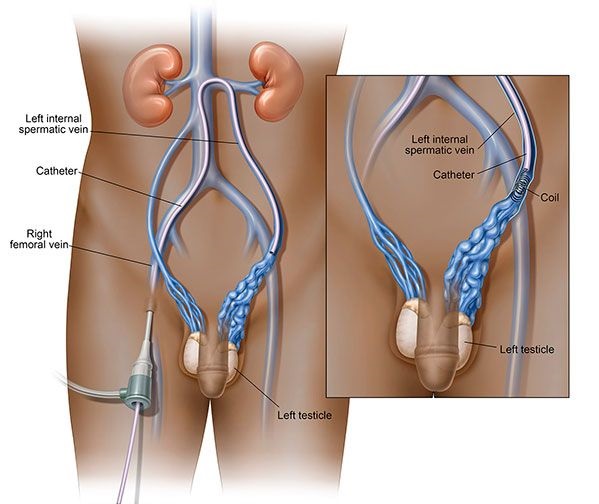What is varicocele?
When the veins of the scrotum becomes enlarged, it causes varicocele. The scrotum is the loose bag of skin that holds the testicles. Chances of having a varicocele on the left side are significantly because of anatomical difference in either side venous drainage from scrotal veins. However many times varicocele on the both sides. Varicocele can start in the teenage however do not get noticed unless they become painful.
How do you know if you have Varicoceles?
In early stage, Varicoceles do not show any major symptoms. That is why they may remain undiagnosed for many years. However, as they grow you may experience the following:
- Swelling in the scrotum
- Dull to sharp recurring pain or discomfort in the scrotum
- Increasing pain over the course of day
- Lying on the back relieves the pain
- Feeling a lump in your testicles especially on the left side
- Twisted and enlarged veins appearing like a bag of worms
- Last but not the least, impaired fertility
- Varicoceles causes low sperm count and low quality sperm both of which are responsible for infertility.
When to see a doctor:
If you are experiencing pain in the scrotum or if you feel a lump in that area, it is advisable to visit an expert to rule it out. Of course, if you are having issues with fertility it is imperative that you see a vascular specialist.
Treatment:
- Non-Surgical Treatment: The most modern and satisfying treatment is varicoceles embolization, no scar-no suture.
- Traditional surgical Treatment: All surgical treatments, whether microscopic or laparoscopic involve blocking of the blood flow in the pampiniform plexus veins but produce scar mark in private part which may be troublesome for some.
Benefits of treating varicoceles without surgery
Before we tell you the advantages of treating varicoceles through non-surgical methods, here is why you should avoid surgery-
- Risk of relapse of the disease
- Scarring due to the invasive procedures
- Risk of infection
- A longer recovery period, especially for the resumption of sexual activities
- Artery damage
- Further testicular atrophy
- Infection
- Bruising, swelling, or a buildup of fluids in the area
- Abdominal pain
Now that you are aware of the downsides of the surgical method, let us show you the benefits offered by the non-surgical process-
Minimum Recovery time:
Recovering from the varicoceles surgery may take anywhere between 3 to 4 weeks. The non-surgical method needs only a couple of days to heal. Treatment without surgery considerably reduces your recovery time and you can go about your normal routine activities as if nothing happened at all. Thus, your work, school, family, in fact, your life in general is not much impacted. A couple of day’s recovery can always be planned around long weekends or holidays allowing you not to disrupt your daily routine.
Incision Free:
During the surgical process, depending on the procedure opted; one or more incisions may be required to ligate all the veins. The incisions are bound to leave a scar. Also, you would require cleaning the incisions and monitoring them carefully to avoid risk of infection to the incised area for up to 6 weeks or until healed completely. On the contrary, for varicoceles embolization, only a small puncture site is needed.
Reduced Risk:
Varicocele embolization is a non-surgical method to treat varicoceles. It can be done in an outpatient setting with minimum time and cost. Therefore, the risks associated with any surgical process do not apply to this treatment. Most importantly, there is no risk of damaging any other artery.
Just 1 day at Hospital:
Embolization is performed in an outpatient facility. Therefore, there is absolutely no need for hospitalization. Just walk in at your designated time, get the treatment performed and walk out.
Early Resumption of Physical Activity:
Treating varicoceles with surgery needs an incision to be done. Hence, doctors would advise little physical activity as a post recovery measure. Not abstaining from sexual and physical activity may tear the incision. Bleeding may start and increase the risk of infection. The general timeline for abstaining is up to 2 weeks from the date of surgery for physical exercises and up to a month for sexual activity.
In sharp contrast, the non-surgical embolization allows you to resume exercises within 7 days and your sexual life within 1-2 weeks.
If a disease can be cured with minimum invasion to the body tissues, it is always wiser to choose that path.
If you have questions about varicose veins management, call 866-996-9729, schedule an appointment with Dr Prashant Pote, and know more about varicocele embolization.






DR.Suresh
The blog was absolutely fantastic! Lots of excellent information that can be useful in one way or another. Keep updating the blog, waiting for more content .Good job, keep it up.
dr Prashant Pote
Thanks you Dr Suresh for appreciation.
DR.Asif
Such a great blog! I am looking for these kinds of blogs for last many days. Thanks for sharing it with us.